By Ella Myer
Societies have always had to grapple with the meaning of death and of the past. The German conceptual historian Reinhart Koselleck (1923–2006) argues, however, that the kind of meaning we ascribe to both fundamentally changed in modernity. Drawing primarily upon his essay collections The Practice of Conceptual History (2002) and Sediments of Time(2018), this piece presents Koselleck’s understanding of how meaning-making in relation to time and violent death changed during what he calls the Sattelzeit or ‘saddle-period’ (1750–1850) of European history. The manifest absurdity of twentieth-century violence informs Koselleck’s broader claim that all history is “meaningless” and that World War II memorials in particular should resist making meaning out of “absurdity.” Koselleck’s work ultimately provokes new questions for other sites of contested memory, such as the U.S. as it grapples with Confederate monuments.
Premodern Meaning
Koselleck argues that premodern Europeans experienced time in broad theological and natural categories, such as Paradise, Fall, and Redemption. With the notable exception of Joachim of Fiore, most people viewed time as static. They believed that they were living in the world’s last epoch and “assumed that nothing fundamentally new could occur until the end of the world” (Practice, p. 161). This epoch organized events chronologically according to natural categories (e.g., the sun, seasons, and reigns of kings) or the Church calendar. “History” (die Historie) in this sense began with Herodotus and entailed the orderly narration of events.
Koselleck argues that premodern Europeans ascribed meaning to the past and to time based on theology and a theory of repetition. Since God directs history, any event could be rendered meaningful in this world or the next. Since there could be nothing new under the sun (nil novum sub sole), history was also life’s teacher (historia magistra vitae). People made prognoses and could be reasonably confident about how to act based on past experience and the slow rate of change.
Premodern Memorials
Within this worldview, Koselleck shows that pre-Sattelzeit monuments to the dead also had inner and, especially, otherworldly meanings. Death was seen as a passageway, not an end. After death, all souls were equal before God, but on earth, representations of the dead were differentiated by estate. Only the deaths of great personages were transfigured into monuments because their roles endured although their earthly lives did not. Fallen soldiers, however, were not remembered by name, nor did the memory of their deaths serve a political function. Soldiers appeared on victory monuments but not yet on war memorials, which concern the meaning of their deaths, and which Koselleck claims did not yet exist.
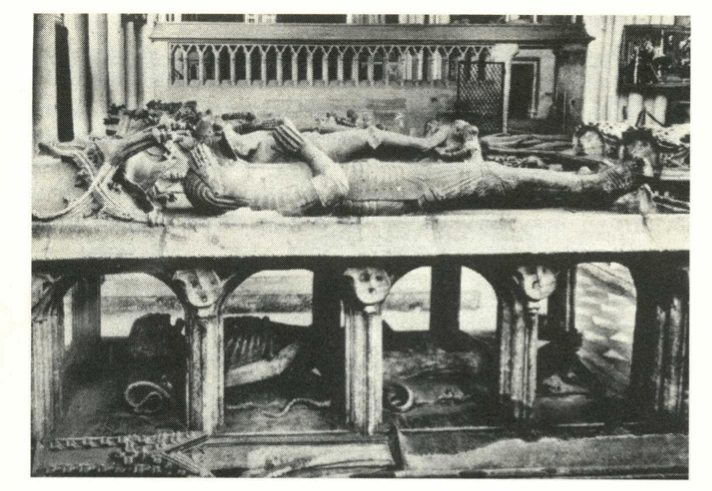
Modern Meaning
During the Sattelzeit, the experience and meaning of time changed dramatically: people became aware of themselves as historical beings living in a “new time” (neue Zeit) or “modernity” (Neuzeit) that arose out of the creation of the “Middle Ages” as a counter-concept. People began to see the past as “other” and to notice their own historical perspective. Koselleck cites Wilhelm von Humboldt: “In the history of all times, the eighteenth century occupies the most favorable position for investigating and appreciating its own character” (Practice, p. 167).
Modern experience began to diverge from premodern expectations: Secularization enabled people to see the world as having an “open future” that was changeable and open to “progress” because neither God nor sin blocked the way. Because of the speed of development (e.g., in production and transportation) and drastically shifting politics (e.g., the French Revolution), people experienced unprecedented temporal “acceleration.” Changes were no longer gradual, expected, or reined in by natural limits (e.g., the speed of a horse or daylight working hours).
These new experiences contradicted “historia magistra vitae.” One’s “space of experience” no longer corresponded to one’s “horizon of expectation.” Koselleck quotes Goethe:
It is bad enough that now one can no longer learn anything for one’s whole life. Our ancestors stuck to the lessons they received in their youth; we, however, have to relearn things every five years if we do not want to fall out of fashion completely.
Practice, p. 113.
This quote highlights modernity’s transitive character: moderns expect their present to transform into a future that will be just as “other” to them as the past. This notion that time itself is moving (rather than people moving through time) was central to modern philosophies of history.
Philosophies of history depend on the expansion of the semantic field of “history.” During the Sattelzeit, a transcendental turn first conceived of “history in and for itself” rather than simply “history writing” like that of Herodotus. History became both an object of scientific investigation and also a subject or force that subsumes all histories into a collective singular that moves through time and makes its own meaning—a “secularized eschatology,” to use the term Koselleck borrowed from Karl Löwith. Philosophers and politicians came to theorize laws that govern this force. Some postulated that history is working toward a utopian telos while others looked to history to justify the present as the necessary outworking of what came before:
In the course of nineteenth-century research, the categories of spontaneity, of historical uniqueness, and of historical forces, which were originally designed with an eye to genuine historical time, became bound up in substances such as personality, the people, class, certain states and so on.
Practice, p. 9.
Koselleck argues that these competing ways of finding meaning in relation to time ultimately laid the groundwork for the twentieth century’s totalitarian ideologies and conflicts.
Modern Memorials
While these theoretical transformations were underway, war memorials were also spreading throughout Europe, displaying new meanings. The timing of their appearance is not coincidental; Koselleck calls them “a common visual signature of modernity” (Practice, p. 299). These modern monuments portray death as an end, without reference to otherworldly perfection. They thematize mourning, sacrifice, and past greatness but not transcendent hope. They render survival meaningful for the living and confer legitimacy on the cause for which the soldiers died.
The new war memorials were also democratic. In modernity, equality is not something one attains only before God. Now, on Earth, every soldier’s name needed to be remembered: It is the remembrance of the dead that is put into political service and not only the act of dying. New monuments helped fuse ordinary soldiers to their states through secular cults of memory.
War memorials work by giving specific, meaningful identities to those killed:
[They can be labeled] as heroes, victims, martyrs, victors, kin, possibly also the defeated; in addition, as custodians or possessors of honor, faith, glory, loyalty, duty; and finally as guardians and protectors of the fatherland, of humanity, of justice, of freedom, of the proletariat or a particular form of government.
Practice, p. 287.
Notice that some of these descriptors presuppose a philosophy of history—they seek to justify the deaths. Second, war memorials offer meaningful identities to onlookers and summon them to respond. Their maxim is “the living are obliged to the dead.” They urge onlookers to unite with their cause so that the dead will not have died in vain and can attain an earthly immortality.
Notable are the Prussian memorials bearing the formula: “In memory of those killed in action, in recognition of the living, for the emulation of future generations” (Practice, p. 295).

Yet Koselleck also documents cases of onlookers pushing back against intended meanings, for example citizens who painted over memorials with Käthe Kollwitz’s catchphrase “Never again war!” or the National Socialists who destroyed memorials that did not align with their agenda.
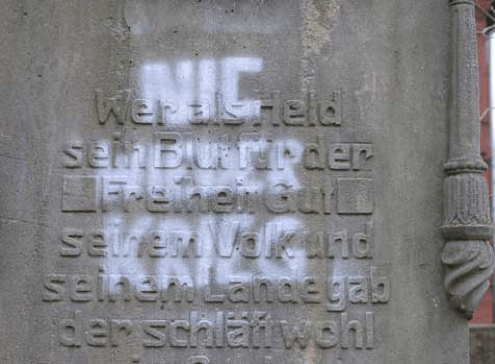
Twentieth-Century Meaninglessness
For Koselleck, the cost of all this meaning is too high and reflects a mistaken understanding of historical structures. “History” and “meaning,” he argues, are words that should always be used in the plural: violent death never has one overarching meaning. Koselleck’s main criticism of philosophies of history is one he shared with Hannah Arendt, whom he read closely: they encourage people to avoid their responsibility to act, entrusting rationality, justice, and power to history as a whole. They also legitimate committing atrocities in the name of historical laws.
For Koselleck, “History is neither a tribunal nor an alibi” (Sediments, p. 195). This means that it is wrongheaded to look for an event’s meaning in its consequences. Stalingrad was not a victory for the forces of production and the Holocaust is not meaningful because it helped establish the state of Israel. Not only do these interpretations ignore the plurality of experiences, they also rationalize the irrational. “Absurdity having become event, it should not also receive some kind of absolution via attributions of meaning after the fact” (Sediments, 195). While Koselleck allows that history writing can be meaningful, “history itself” is meaningless.
Koselleck aimed to develop a non-ideological theory of “history in the plural”: events “pile up” at different temporal rhythms, never forming a cohesive whole. He rejects historical necessity and teleology and challenges the tendency of historians to create linear causal chains. Instead, his nuanced theory of history attempts to uncover “possible histories” and underlying repetitive structures, challenging the Enlightenment idea that history is unique. In a limited sense, there is truth in the premodern idea of historia magistra vitae. Specifically, there are “several formal durable determinations [that are] undoubtedly inherent in human nature,” namely the fundamental oppositions “earlier-later, inside-outside, and above-below” (Sediments, p. 252).
Post-World War Two Memorials
The Second World War ruptured the modern European memory cult. People not only had to confront soldier causalities numbering in the millions but also come to terms with millions of senselessly murdered civilians. In Western Europe, there has been broad consensus that modern war memorials cannot handle the Second World War’s scale or ideological nature. A trend has emerged to create abstract memorials or “negative monuments” that symbolize meaninglessness:
Walls that leave open a slit that allows light to shine through, so that one can see the outside from inside without being able to exit…Or hollow forms of people who have disappeared are poured or carved out again and again, the negation of the human being…[Or] memorials that themselves disappear.
Sediments, p. 248.
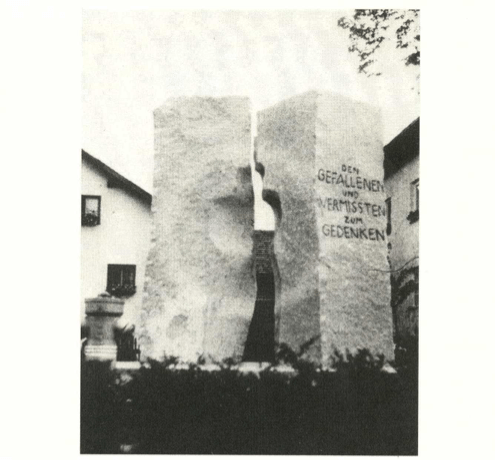
These memorials do not provide meanings but rather ask whether there is meaning at all in the events they memorialize. They also allow for different, potentially contradictory answers, including negative ones. However, their openness has not precluded fierce debate about them.
In 1993, Koselleck himself entered into the debate over the rededication of the newly unified Germany’s memorial to the “Victims of War and Dictatorship” (the Neue Wache), which incensed him because it violated many of his above convictions. Its centerpiece is a pietà, which problematically implies that the dead were willing martyrs whose deaths have redemptive meaning. This was not the case for the majority of those killed. In fact, the Nazis prevented many victims from meaningfully sacrificing themselves. The memorial is also problematically singular. The Christian-inspired pietà fails to represent Jews and, as icons of maternal grief, fails to represent women, the majority of civilian deaths. Furthermore, its inscription, “To the Victims of War and Tyranny,” collapses victim and perpetrator and fails to differentiate between experiences: “[It] disguises what happened and ignores the brutal and absurd truth of our history.” Koselleck controversially proposed to change the inscription to: “To the Dead: Fallen, Murdered, Gassed, Died, Missing.” This recognition of fundamentally different experiences, Koselleck hoped, might enable his country to come to terms with its plurality of histories.
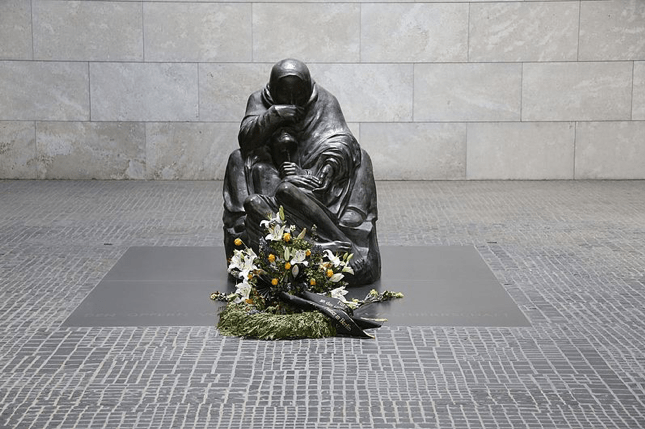
If Koselleck is right that history is both plural and meaningless, what difference might this make in other sites of contested memory, such as the contemporary United States? Is it wise to negate the meaning projected by Confederate monuments by taking them down and replacing Lost Cause rhetoric with an alternative unified history? Might a case instead be made for pluralizing the memorial scene by adding counter-monuments of other figures or new inscriptions alongside existing ones? Would that risk legitimizing Confederate apologetics as a viable interpretation, or might it instead highlight their absurdity while still preserving traces of those who died defending slavery? In any case, Koselleck’s work not only reveals the ideological conception of unified historical meaning underlying the anachronistic monuments in question, but also develops plural and negative alternatives that can open up new ways forward.
Ella Myer is an M.Div. Candidate at Princeton Theological Seminary.
Featured Image: Protesters hang a banner on a statue of Confederate soldier John B. Castleman in Louisville, KY, August 19, 2017. Reuters photo: Bryan Woolston.
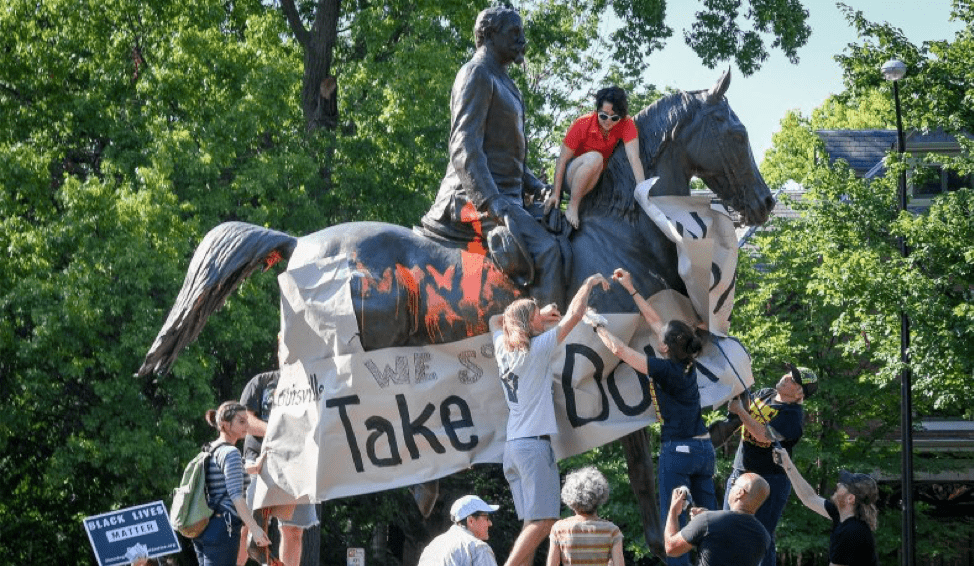



December 11, 2019 at 6:31 am
Thank you, this is a great read. A recent documentary related to the topic is titled: Monumental Crossroads. The documentary explores Southern Heritage and the removal of confederate monuments. It is interesting to watch it in conjunction with reading this article.